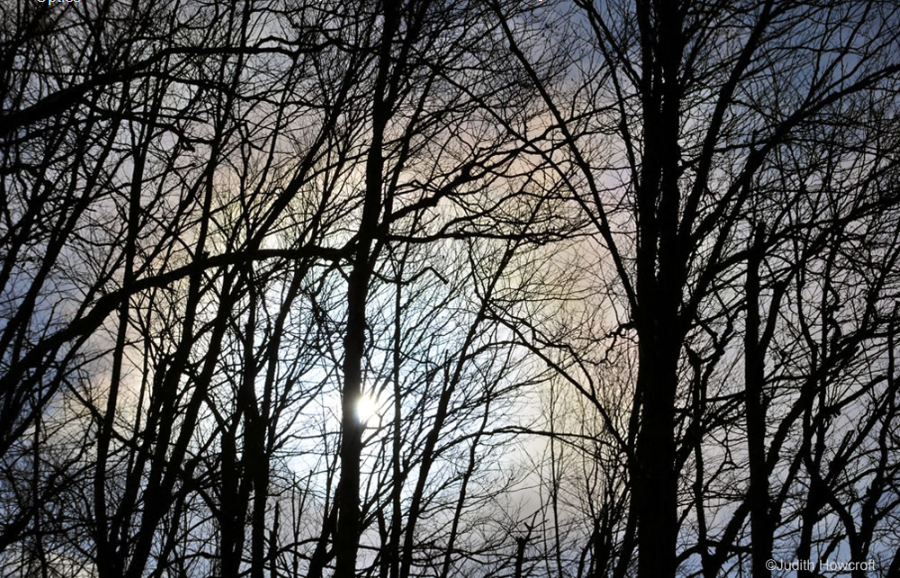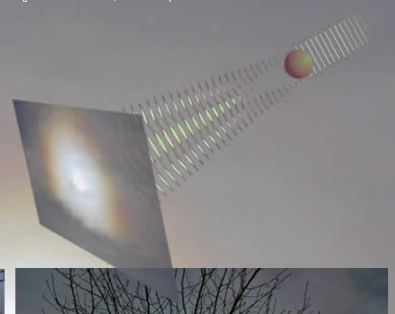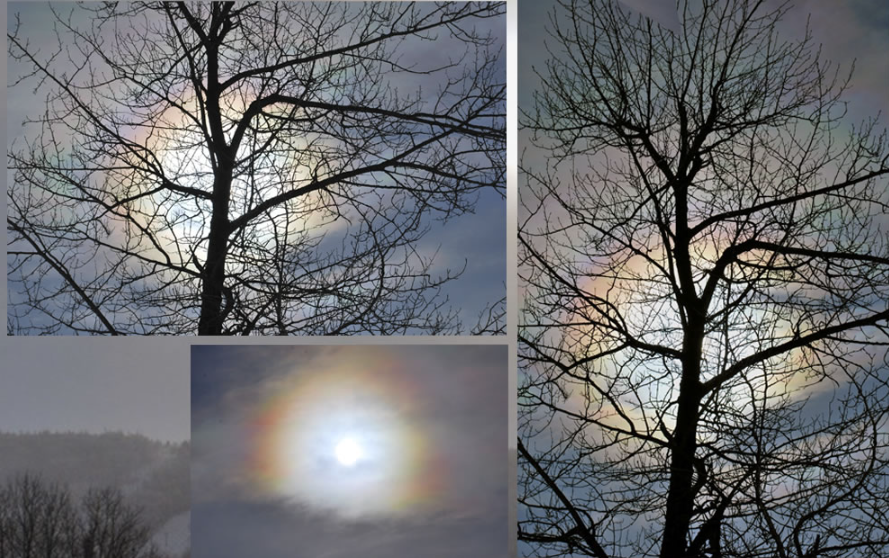Coronal Sun
The Phenomenon of the Coronal Sun
The coronal sun is a captivating atmospheric optics phenomenon that occurs when a series of multi-colored rings surround a bright central aureole centered on the sun or moon. These rings, known as a corona, are typically a few degrees across, roughly the width of a clenched hand when observed at arm's length. The corona is formed when small water droplets in thin cloud or mist diffract light, creating a mesmerizing interference pattern in the sky.
To understand the formation of a corona in more detail, imagine light waves incident on a droplet being scattered by its surface. Each point on the droplet's rim produces a set of outgoing spherical waves. When these waves overlap, they interfere with each other. Where wave crests coincide, light is visible, resulting in the corona pattern that we observe. The corona exhibits a range of colors because the diffraction pattern for each color is of a different size, and our eyes perceive the composite of all these colors overlapping.
While a diagram may depict a single drop easily producing a coronal diffraction pattern in a darkened laboratory, the corona we see in the sky is the culmination of the contributions of millions of droplets spread across the cloud. Each individual droplet plays a role in shaping the intricate and ethereal display of the corona.
The Science Behind the Coronal Sun
The corona's colorful appearance is due to the diffraction of light as it passes through the water droplets in the cloud or mist. This diffraction occurs when light waves encounter an obstacle or pass through an aperture, causing them to bend and spread out. As the sunlight interacts with the tiny water droplets, it undergoes diffraction, resulting in the characteristic rings of the corona.
The size and spacing of the water droplets determine the size and intensity of the corona. Smaller droplets produce more vibrant and defined rings, while larger droplets create a more diffuse and less pronounced corona. The thickness and density of the cloud or mist also influence the appearance of the corona. Thinner clouds may produce a more delicate and intricate corona, while denser clouds can yield a bolder and more prominent display.
Observing the Coronal Sun
The corona is most commonly observed when the sun is partially obscured by thin clouds or mist. These atmospheric conditions provide the ideal environment for the formation of the corona. However, it is important to note that the corona is not always visible, as it requires specific conditions to occur.
To enhance your chances of witnessing this captivating phenomenon, consider the following tips:
- Look for thin, wispy clouds or mist that partially obscure the sun.
- Position yourself so that the sun is at an angle, rather than directly overhead.
- Shield your eyes from direct sunlight to reduce glare and improve visibility.
- Be patient and observant, as the corona may appear and disappear rapidly.
The Beauty and Significance of Atmospheric Optics
The coronal sun is just one example of the breathtaking phenomena that occur within our atmosphere. Atmospheric optics encompasses a wide range of optical effects caused by the interaction of light with particles, clouds, and other atmospheric elements. These phenomena not only inspire awe and wonder but also provide valuable insights into the behavior of light and the complex nature of our atmosphere.
By studying atmospheric optics, scientists gain a deeper understanding of how light interacts with different atmospheric components, leading to advancements in meteorology, climate science, and remote sensing technologies. Furthermore, these phenomena serve as a reminder of the inherent beauty and intricacy of our natural world, encouraging us to appreciate and protect the environment in which we live.
In conclusion, the coronal sun represents a stunning manifestation of atmospheric optics. Its vibrant rings and ethereal appearance are the result of the diffraction of light by water droplets in thin cloud or mist. While observing the corona requires specific atmospheric conditions, it is a captivating sight that reminds us of the wonders and complexities of our atmosphere. Through continued exploration and study of atmospheric optics, we can unravel the mysteries of these phenomena and gain a deeper appreciation for the natural world around us.

Winter Corona ~ A wintry sun shines through Northern New Hampshire trees. The pastel hued rings of a corona surround the sun. Images by freelance photographer Judith Howcroft (Wilderness Light Photography). All images ©Judith Howcroft, shown with permission.

A corona is a series of multi-coloured rings surrounding a bright central aureole centred on the sun or moon. It is typically a few degrees across. Stretch out your arm and the corona will be the width or less of a clenched hand. Small water droplets in thin cloud or mist produce it. They individually diffract light to produce the large interference pattern in the sky that we call a corona.
In more detail, to form a corona light incident on a droplet is mostly scattered by its surface. Imagine plane light waves scattered from two points on the rim. Each point produces a set of outgoing spherical waves. Where the waves overlap they interfere. Where both wave crests coincide there is light. The total result a long distance away is the corona pattern we see. The corona is coloured because the diffraction pattern for each colour is a different size and we see the overlapped composite of all colours. The diagram is somewhat fanciful. While in a darkened laboratory a single drop can easily produce a coronal diffraction pattern on a screen, the corona we see in the sky is the sum of contributions of millions of droplets spread across the cloud.

Note: this article has been automatically converted from the old site and may not appear as intended. You can find the original article here.
Reference Atmospheric Optics
If you use any of the definitions, information, or data presented on Atmospheric Optics, please copy the link or reference below to properly credit us as the reference source. Thank you!
-
<a href="https://atoptics.co.uk/blog/coronal-sun/">Coronal Sun</a>
-
"Coronal Sun". Atmospheric Optics. Accessed on April 23, 2024. https://atoptics.co.uk/blog/coronal-sun/.
-
"Coronal Sun". Atmospheric Optics, https://atoptics.co.uk/blog/coronal-sun/. Accessed 23 April, 2024
-
Coronal Sun. Atmospheric Optics. Retrieved from https://atoptics.co.uk/blog/coronal-sun/.